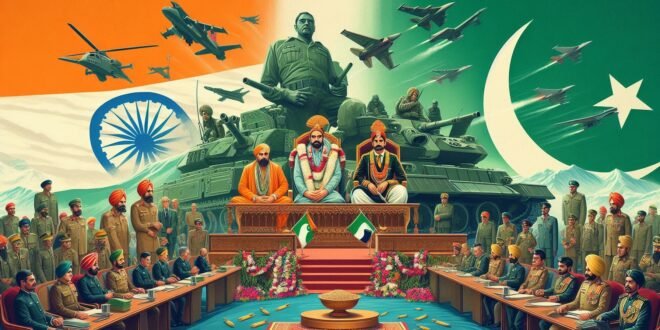The drums of war between India and Pakistan beat louder with each headline, yet the last official war ended in 1971. What unfolds today is a high-stakes shadow conflict – a volatile cocktail of terrorism, covert strikes, and nuclear brinkmanship that could ignite at any moment.
The 2019 Flashpoint: When War Almost Returned
The closest the rivals came to full-scale war in decades erupted over 72 hours in February 2019:
- Pulwama Attack (Feb 14)
A Jaish-e-Mohammed suicide bomber killed 40 Indian paramilitary troops in Kashmir. India blamed Pakistan’s ISI. - Balakot Airstrike (Feb 26)
Indian MiG-21s crossed the Line of Control (LoC) and bombed a JeM camp in Pakistan’s Khyber Pakhtunkhwa – the first air strike on Pakistani soil since 1971. - Aerial Dogfight (Feb 27)
Pakistan retaliated:- F-16s downed an Indian MiG-21
- Pilot Abhinandan Varthaman captured (later returned)
- India claimed it shot down a Pakistani F-16
The Nuclear Calculus:
*”Both armies were at Alert Level-1. Tactical nukes were armed.”*
– Former RAW Chief A.S. Dulat
Why Full-Scale War Hasn’t Happened (The 4 Deadlocks)
| Factor | India’s Hand | Pakistan’s Hand |
|---|---|---|
| Nuclear Deterrence | No first-use policy | Tactical nukes deployed |
| Geography | Punjab plains favor invasion | Indus River = natural moat |
| Economy | War would cost 8% of GDP | 3 weeks of war = bankruptcy |
| Global Pressures | Quad alliance commitments | China’s $62B CPEC investment |
Military Reality:
- India’s “Cold Start Doctrine” (rapid strikes) remains untested
- Pakistan’s “Full Spectrum Deterrence” relies on battlefield nukes
The New Battlefields (2020-2024)
While tanks stay silent, conflict rages elsewhere:
- Drone Wars
- 298 Pakistani drones shot down (2021-2024) carrying weapons/drugs
- India’s counter: Laser fences & anti-drone systems along Punjab border
- Cyber Front
- 2023: Indian power grids faced 47X spike in attacks (Group-IB)
- Pakistan’s “SideCopy” hackers target defense networks
- Proxy Terrorism
- 65% drop in Kashmir militancy since 2019 (South Asia Terrorism Portal)
- But 2023 saw resurgence: 30 security forces killed in Rajouri-Poonch
- Water Warfare
- Pakistan protests India’s hydropower projects on Indus tributaries
- Climate change intensifies disputes over melting glaciers
The Human Cost: War by Other Means
Kashmir’s Trauma:
- 450+ conflict deaths since 2019 (50% civilians)
- 10,000+ displaced along LoC in 2022 ceasefire violations
Economic Bleeding:
| Cost | India | Pakistan |
|---|---|---|
| Annual defense spending | $72.6 B | $10.4 B |
| Trade losses due to tensions | $3.2 B/year | $2.1 B/year |
| War preparedness (2024) | 40% of CAPEX | 35% of budget |
Why Peace Efforts Fail (The 3 Toxic Cycles)
- Attack-Response Trap
Pulwama → Balakot → Dogfight → Escalation - Kashmir Obsession
Pakistan’s identity tied to the dispute; India sees it as territorial integrity - Army-Deep State Nexus
Pakistan’s military-industrial complex thrives on anti-India posture
Pathways from the Precipice
- The 2021 Ceasefire Miracle
- Secret RAW-ISI talks brokered by UAE
- Result: 98% reduction in LoC firing (holding as of July 2024)
- Economic Carrots
- Medical tourism: 65,000 Pakistanis treated in India yearly
- Informal trade: $4.9B/year via Dubai
- Climate Cooperation
- Real-time glacial melt data sharing since 2022
- Joint flood warning systems in Punjab
What If War Actually Came? (Expert Projections)
Phase 1 (Conventional)
- Indian armored thrusts toward Lahore/Multan
- Pakistani counterstrikes in Kashmir
Phase 2 (Nuclear Threshold)
- Pakistan uses tactical nukes after 72 hrs (Brookings study)
- India retaliates with strategic strikes
Endgame
- 125 million casualties in 1 week (Princeton Univ simulation)
- Global GDP drops 7% (IMF estimate)
Conclusion: The War That Must Never Be Fought
India-Pakistan tensions resemble a nuclear reactor operating at 99% capacity – stable until one rod slips. As strategist Brahma Chellaney warns:
“We’ve normalized walking to the cliff’s edge. But gravity always wins.”
The only victory lies not in generals’ medals but in silenced guns. Until then, the subcontinent remains hostage to what historian Ramachandra Guha calls “the world’s most dangerous game of chicken.”
 Speed Khabar
Speed Khabar




